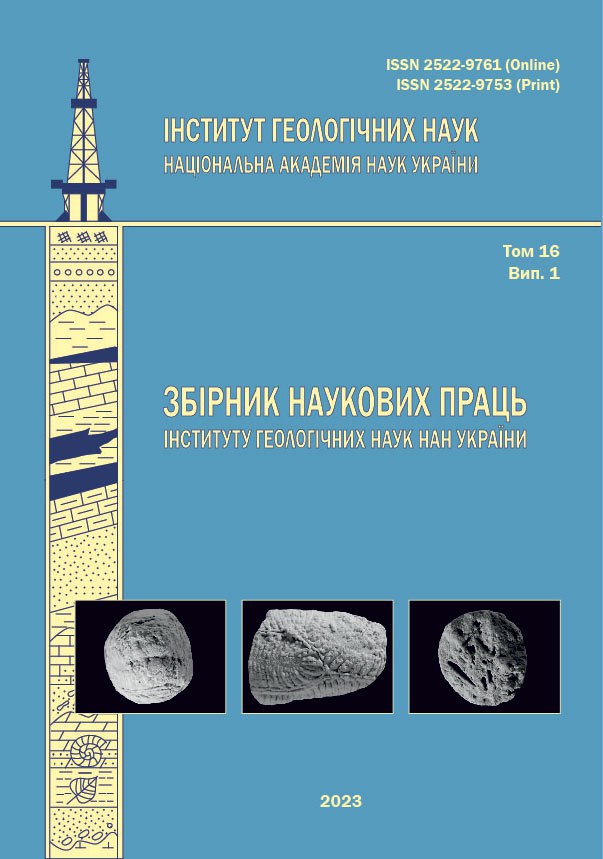ВИЗНАЧЕННЯ ПАРАМЕТРІВ ВОДООБМІНУ І МОДЕЛЮВАННЯ ГЕОФІЛЬТРАЦІЙНИХ ПРОЦЕСІВ В ЗОНІ ВПЛИВУ УРАНОВОГО ХВОСТОСХОВИЩА «ЗАХІДНЕ» ПРИДНІПРОВСЬКОГО ХІМІЧНОГО ЗАВОДУ
DOI:
https://doi.org/10.30836/igs.2522-9753.2023.291210Ключові слова:
підземні води, інфільтраційне живлення, трасерний експеримент, гідрогеологічне моделювання, Придніпровський хімічний заводАнотація
Представлені результати польових гідрогеологічних досліджень з визначення параметрів водообміну і прогнозного моделювання геофільтраційних процесів у зоні впливу уранового хвостосховища «Західне», що належить до Придніпровського хімічного заводу, м. Кам’янське. Виконані гідрогеологічні спостереження дозволили уточнити інфільтраційне живлення підземних вод досліджуваної ділянки в межах першої тераси (200 мм/рік) і другої тераси (150 мм/рік) р. Дніпро. На основі трасерного експерименту дійсна швидкість фільтрації підземних вод у безнапірному водоносному горизонті в піщаних алювіальних відкладах у зоні впливу хвостосховища оцінена в 0,26–0,52 м/добу. Визначені параметри водообміну і дані моніторингу рівнів підземних вод були використані для побудови і калібрування моделі геофільтраційних процесів на ділянці між хвостосховищем «Західне» і р. Коноплянка на основі програми Visual Modflow. Час фільтрації підземних вод у безнапірному водоносному горизонті від хвостосховища до р. Коноплянка оцінюється на відкаліброваній моделі в 13 років, що помітно менше, ніж попередні оцінки на регіональній фільтраційній моделі (20 років). Були змодельовані кілька сценаріїв ремедіаційних заходів, що дозволило обґрунтувати рекомендації щодо поліпшення захисту підземних і поверхневих вод від радіоактивного забруднення
Посилання
Bugai D. О., Zanoz B. Yu., Lavrova T. V., Korychensky K. O., Kubko Yu.I., Avila R., Rets Yu.M., 2021. Development of the groundwater monitoring system in the zone of influence of uranium production legacy facilities of the Prydniprovsky Chemical Plant. Geologičnij žurnal. 4 (377). Pp. 56–70. https://doi.org/10.30836/igs.1025-6814.2021.4.240111 (In Ukrainian).
Zanoz B. Yu., Tkachenko К. Yu., Bugai D. O., 2021. Analysis of hydrogeological and geochemical factorsgoverning migration of radionuclides and toxic metals from uranium tailings to groundwater. Collection of scientificworks of the Institute of Geological Sciences NAS of Ukraine. Vol. 14, iss. 2. Pp. 83–95. (In Ukrainian). https://doi.org/10.30836/ igs.2522-9753.2021.245705.
Kuzovov Yu. I. Pridneprovskiy Chemical Plant (historical review). Dnepropetrovsk: Poligrafist, 1997. 160 p. (In Russian).
Lavrova, T. V., Korychenskyi, K. O., Voitsekhovych, O. V., 2022. Assessment of temporal and space-time changes of groundwater chemical composition at the “Рridniproivsky chemical plant” uranium production legacy site. Hidrolohiia, hidrokhimiia i hidroekolohiia. Hydrology, Hydrochemistry and Hydroecology. № 4 (66). Pp. 81–95. https://doi. org/10.17721/2306-5680.2022.4.9. (In Ukrainian).
Protsak V. P., Kashparov V. O., Kirichenko V. K., Kalyabina I. L., Marinich O. V., Maloshtan I. M., Levtchuk S. E., Prokopchuk N. M., 2013. Evaluation of the parameters of migration of the uranium series radionuclides in the tailings of the Pridneprovskiy chemical plant. Nuclear Physics and Atomic Energy. Vol. 14 (1). Pp. 55–63. (In Ukrainian).
Saprykin V. Yu., Bugai D. O., Skalskyi O. S., 2019. Model estimation of moisture infiltration rates through engineered soil covers of the uranium mill tailings at the Pridneprovsky chemical plant (Kamianske). Collection of scientificworks of the Institute of Geological Sciences NAS of Ukraine. Vol. 12. Pp. 84–94. (In Ukrainian). https://doi.org/10.30836/ igs.2522-9753.2019.185747.
Tkachenko E., Skalskyy A., Bugai D., Lavrova T., Protsak V., Kubko Yu., Avila R., Zanoz B., 2020. Monitoring of technogenic contamination of groundwater and surface water in the zone of influence of uranium tailings of the Pridneprovsky Chemical Plant (Kamyanske). Geological Journal. No. 3 (372). Pp. 17–35. https://doi.org/10.30836/igs.1025-6814.2020.3.206341 (In Ukrainian).
Churaev N. V., Ilyin N. I., 1967. Radio-indicator methods for characterization of groundwater flow. Atomizdat Publishers, Moscow124 p. (In Russian).
Bugai D. O., Laptev G. V., Skalskyy O. S., Lavrova T. V., Avila R., 2015. Analysis of spatial distribution and inventory of radioactivity within the uranium mill tailings impoundment. Nuclear Physics and Atomic Energy. Vol. 16, no. 3. Pp. 254– 261. https://doi.org/10.15407/jnpae2015.03.254.
Doherty J., and Hunt R. J., 2010. Approaches to highly parameterized inversion: A guide to using PEST for groundwater-model calibration: USGS Scientific Investigations Report 2010–5169. Reston: U. S. Geological Survey. 59 p. https:// doi.org/10.3133/sir20105169.
Gumuła-Kawęcka A., Jaworska-Szulc B., Szymkiewicz A., Gorczewska-Langner W., Pruszkowska-Caceres M., Angulo-Jaramillo R., Simůnek J., 2020. Estimation of groundwater recharge in a shallow sandy aquifer using unsaturated zone modeling and water table fluctuation method. Journal of Hydrology. Vol. 605. P. 127283 https://doi.org/10.1016/j. jhydrol.2021.127283.
Healy R. W., Cook P. G., 2002. Using groundwater levels to estimate recharge. Hydrogeology Journal. Vol. 10. Pp. 91–109. https://doi.org/10.1007/s10040-001-0178-0.
Hughes A., Mansour M., Ward R., Kieboom N., Allen S., Seccombe D., Charlton M., Prudhomme C., 2021. The impact of climate change on groundwater recharge: National-scale assessment for the British mainland, Journal of Hydrology, Vol. 598, P. 126336, https://doi.org/10.1016/j. jhydrol.2021.126336.
Johnson A. I., 1967. Specific yield — Compilation of specific yield for various materials. Geological Survey water supply paper 1662D, Washington: U. S. Government printing office. 80 p.
Lavrova T., Voitsekhovych O., 2013. Radioecological assessment and remediation planning at the former uranium milling facilities at the Pridnieprovsky Chemical Plant in Ukraine. J. Environ. Radioact. Vol. 115. Pp. 118–123. https:// doi.org/10.1016/j.jenvrad.2012.06.011.
Martinsen G., Bessiere H., Caballero Y., Koch J., Collados-Lara A. J., Mansour M., Sallasmaa O., Pulido-Velazquez D., Hunter Williams N., Zaadnoordijk W., Stisen S., 2022. Developing a pan-European high-resolution groundwater recharge map — Combining satellite data and national survey data using machine learning. Sci. Total Environ. Vol. 822. P. 153464 http://dx.doi.org/10.1016/j.scitotenv.2022.153464.
McDonald, M. G., Harbaugh, A. W. A modular three-dimensional finite-difference ground-water flow model. In: Techniques of Water-Resources Investigations, Book 6. Reston: U. S. Geological Survey, 1984. 528 p.
Riedel T., Weber T., 2020. Review: The influence of global change on Europe’s water cycle and groundwater recharge. Hydrogeology Journal. Vol. 28. Pp. 1–21. https://doi. org/10.1007/s10040-020-02165-3.
Skalskji O., Bugai D., Voitsekhovych O., Ryazantsev V., Avila R., 2011. Groundwater monitoring data and screening radionuclide transport modeling analyses for the uranium mill tailings at the Pridneprovsky Chemical Plant Site (Dneprodzerzhinsk, Ukraine). In: Merkel B., Schipek M. (Eds.), The New Uranium Mining Boom. Challenge and lessons learned, Verlag, Berlin, Heidelberg: Springer. Pp. 219–228. https://doi. org/10.1007/978-3-642-22122-4.
Tkachenko Y., 2020. The Prydniprovsky Chemical Plant — Ukraine’s uranium heritage. Survey report on the activity history and the modern state of the former production association «Prydniprovsky Chemical Plant». Oslo: Bellona Foundation. 121 p.


